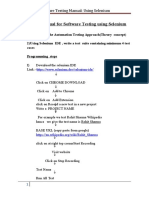0% found this document useful (0 votes)
35 views3 pagesUnix Commands for Parcel and Booking Data Analysis
The document contains a series of Unix commands using awk to manipulate and extract data from text files related to parcel bookings and customer information. It includes commands to count delivered parcels, display specific booking details, find total bookings by a customer within a date range, filter customer records, update customer email, and sort booking details. Each command is tailored to process data formatted with specific delimiters and conditions.
Uploaded by
Domakonda NehaCopyright
© © All Rights Reserved
We take content rights seriously. If you suspect this is your content, claim it here.
Available Formats
Download as TXT, PDF, TXT or read online on Scribd
0% found this document useful (0 votes)
35 views3 pagesUnix Commands for Parcel and Booking Data Analysis
The document contains a series of Unix commands using awk to manipulate and extract data from text files related to parcel bookings and customer information. It includes commands to count delivered parcels, display specific booking details, find total bookings by a customer within a date range, filter customer records, update customer email, and sort booking details. Each command is tailored to process data formatted with specific delimiters and conditions.
Uploaded by
Domakonda NehaCopyright
© © All Rights Reserved
We take content rights seriously. If you suspect this is your content, claim it here.
Available Formats
Download as TXT, PDF, TXT or read online on Scribd
/ 3


























































































